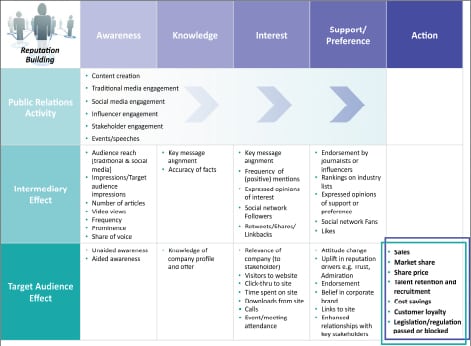My guess is you’ve heard of the Barcelona Principles, which were created in 2010 by five major PR industry associations including the International Association for Measurement and Evaluation of Communications (AMEC) and the Institute for Public Relations (IPR). The seven principles were a major step toward developing standards and professionalizing how we approach PR measurement.
But you may not have heard about the AMEC Valid Metrics Framework, which were developed by an AMEC task force following the launch of the Barcelona Principles, and provide the nitty-gritty framework needed to execute on Barcelona thinking.
The philosophy behind the guidelines states that to truly demonstrate the value of PR, metrics need to be linked to the business objective of the program, and move beyond measuring outputs to measuring outcomes. The Framework helps you identify suitable metrics for PR and social media programs that take you from cursory to meaningful measures that resound with the C-suite and help you refine your programs.
I’ve now had the privilege of working with several clients who needed help crafting measurement methodologies and found the AMEC Framework to be a veritable “magic bullet” in my toolkit. I’ve chosen to reprise it here in the hope that it might become of great help to you.
THE MATRICES
The Valid Metrics Framework, which can be found on amecorg.com, is realized in eight matrices that have been applied to the following types of campaigns: Brand/Product Marketing; Reputation Building; Issues Advocacy/Support; Employee Engagement; Investor Relations; Crisis/Issues Management and Not-for-Profit, Social/Community Engagement.
Within the matrices, three phases have been defined to reflect a simplified breakdown of how PR works: The messages or story is created and told; the story is disseminated via a third party/intermediary, (such as journalists, influencers or bloggers); and, the story is consumed by the target audience, which leads to changes in behavior and business results. These three phases are thus reflected in the Vertical Axis of each matrix as follows:
• Public Relations Activity— Metrics reflecting efforts in producing and disseminating messages.
• Intermediary Effect— Metrics reflecting third-party dissemination of messages to target audiences.
• Target Audience Effect— Metrics showing the target audience has received the messages and any resulting action-driven outcomes.
The horizontal axis then reflects what is commonly known as the Communications or Marketing Funnel with five stages: awareness, understanding, interest/consideration, support/preference and action.

When using AMEC’s Valid Metrics Framework matrix, your goal is to move diagonally across the
matrix, from top left to bottom right, ending with some solid “actions.” (Download at amecorg.com.)
Within each Matrix, suitable metrics have been grouped to help you demonstrate a campaign’s success vertically (from simple activity to output and outcome results) and horizontally (through the five communications stages). The goal is to move diagonally across the matrix, from top left to bottom right.
It all boils down to your objectives and what you are trying to accomplish. Once you’ve defined all that, you simply follow the AMEC Valid Metrics Framework instructions:
1. Choose the grid that best fits your campaign.
2. For “Public Relations Activities” just count your efforts. For example, for “Content Created” you might count number of tweets, number of posts, number of videos, etc.
3. For “Intermediary Effect,” review the matrix ideas and choose what works for you. For example, for Reputation good bets are key message alignment, endorsements, retweets/shares and linkbacks.
4. For “Target Audience Effect,” review the matrix ideas and again, choose what works. If surveys are needed, online polls and DIY approaches are cost-effective, and website activity can be a great proxy.
5. Finally, for the “Action” box determine at least one business/organizational outcome that is relevant to management and feasible to track. Work with your client, or other internal departments, to get business data such as sales, survey scores and market share information.
Consider correlating your Intermediary Effects and Target Audience Effects to uncover the magic link.
 |
Meanwhile, here are a few lessons learned from my experience with the matrices:
• Start by creating a blank matrix and plotting your current measurement measures to see where you are focused, and where you need to grow.
• Read “Guidelines for Setting Measurable Public Relations Objectives: An Update” from the IPR Measurement Commission and restate your objectives clearly.
• Don’t make yourself crazy by measuring too much. Choose a couple of solid metrics in the most important phases of your program that are affordable and manageable.
• Finally, put your new measurement plan into another blank template and see if it shows progression toward the bottom right corner. If so, you are on your way. PRN
CONTACT:
Angela Jeffrey is founder of MeasurementMatch.com, a measurement consultancy. She is also a member of the Institute for PR Measurement Commission, International. Follow her on Twitter @ajeffrey1 or at [email protected].

One response to “AMEC’s Valid Metrics Framework: Magic Measurement Bullet?”